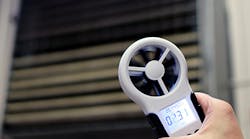Medical facilities are scrambling to assure safety for health care professionals and patients. HVAC professionals are called to test and adjust HVAC systems to verify that airflow and outside air volumes comply with current standards and regulations. Let’s take a look at how you can calculate and adjust air changes and air exchanges per hour in medical facilities.
State and federal codes require testing, adjusting, and verification of room air changes and outside air exchanges in healthcare facilities. Regulations follow ASHRAE Standard 170, 62.1, and 62.2, and are included in the Uniform Mechanical Code (UMC), Unified Facilities Criteria (UFC), as well as the American Society of Healthcare Engineering (ASHE), to name a few.
Using proven healthcare standards, you can test, adjust, and control air in indoor environments. These principles can apply from cleanrooms down to an infected child’s bedroom, and everything in between. Unfortunately, this short article can only provide an overview of air changes and air exchanges to help increase your knowledge and awareness of these requirements.
Air control is designed and engineered in theory. It is accomplished only when an operating HVAC system is built, tested, adjusted, and documented to perform in the field as it was designed.
Air Changes Per Hour
Air Changes per Hour (ACH) is a prescribed measurement and calculation process assuring air is replaced in a room a specified number of times in an hour. This assures adequate indoor air quality, ventilation, and cleanliness.
Required air changes per hour vary depending on the specified use of the room. Surgical rooms may require 20 ACH; emergency rooms, 12 ACH; and patient rooms 6 ACH.
Let’s begin with the air changes per hour formula:
Air Changes Per Hour = Room CFM x 60 ÷ Room Volume in Cubic Feet
Scenario – What would be the air changes per hour of a positive pressure patient room measuring 15 feet wide by 20 feet long by 10 feet high if room airflow was measured at 200 cubic feet per minute (cfm)? A patient room typically requires 6 air changes per hour.
1. You measured the total airflow volume into the room at 200 cfm. Airflow is measured using an air balancing hood or an anemometer at the point where air is delivered into the room. This is normally at the supply registers.
2. Multiply the room’s measured total supply cfm by 60 minutes in an hour to convert to cubic feet per hour (cfh). The equation looks like this: 200 cfm x 60 minutes per hour = 12,000 cfh.
3. Since air changes are based on the volume of the room, calculate the patient room volume. (15’ x 20’ x 10’ = 3,000). The room volume is 3,000 cubic feet.
Calculate Air Changes per Hour (ACH) by dividing the supply airflow of 12,000 cfh by the patient room volume of 3,000 cubic feet. (12,000 cfh ÷ 3,000 cubic feet). = 4.
To diagnose the room’s ACH, compare your measured 4 ACH to the code required for patient rooms (6 ACH). It is clear that additional airflow is needed in the room.
Calculate Required Room Airflow
Next, calculate what the required room cfm must be to bring the room into compliance with the required ACH. Too do this, multiply the volume of the room in cubic feet by required air changes per hour. Then divide by 60 minutes in an hour to find required supply airflow in cubic feet per minute.
Required CFM = Room Cubic Feet x Required Air Changes Per Hour ÷ 60
Scenario - Using the subject patient room with a volume of 3,000 cubic feet, calculate the required room cfm to meet the required 6 air changes per hour. Multiply the room volume of 3,000 cubic feet by the required ACH of 6 = 18,000. Then divide 18,000 by 60 to find required room airflow of 300 cfm.
Air Exchanges Per Hour
Air exchanges per hour (AEH) addresses only the volume of fresh or outside air required into a room per hour. In comparison, ACH considers the total air (recirculated and outside air) brought into a room. Outside air keeps inside air fresh and also pressurizes a building.
The minimum required AEH differs depending on the use of the room. For example, surgical rooms may require 4 AEH, while ER patient rooms require 2 AEH.
If the air-moving equipment serves a variety of medical rooms, the outside air is set to satisfy the requirement of the room with the highest air exchanges per hour. Remember, the regulations for air changes are the minimum values. Additional outside air is acceptable.
Scenario – We’ll use the same patient room with a volume of 3,000 cubic feet. The minimum outside air exchange per hour requirement is 2. The airflow leaving the air-moving equipment serving this and many other rooms is 9860 cfm. Outside air is measured at 2400 cfm. What is the total cfm required into the patient room to assure the outside air exchange of 2 times per hour is satisfied?
1. Using an airflow traverse method, you measured and recorded 9860 cfm leaving the air-moving equipment.
2. You also traversed the outside air volume brought into the air-moving equipment and measured 2400 cfm.
3. Divide outside air cfm into the total air-moving equipment cfm to find the outside air percent.
Percent of Outside Air = Outside Air CFM ÷ Air Moving Equipment Total CFM
You measured outside air at 2400 cfm ÷ air moving equipment cfm of 9860 = 24% outside air.
4. Finally, apply the AEH formula, which is similar to the ACH formula, except the total room cfm is multiplied by the percent of outside air:
Air Exchanges Per Hour = Room CFM x Percent of Outside Air x 60 ÷ Room Volume in Cubic Feet
200 cfm of patient room supply airflow x 24% outside air x 60 = 2880 cubic feet of outside air into the patient room per hour. Divide 2880 into the patient room volume of 3000 to find .96 AEH.
To diagnose minimum outside air exchange performance, compare .96 AEH to the required 2 AEH. This reveals the room has less than half the required volume of Outside Air Exchanges per hour. Either the percent of outside air would need to be increased to the system or the total system airflow to the room would need to be increased.
Air Exchanges Per Hour = Room CFM x Percent of Outside Air x 60 ÷ Room Volume in Cubic Feet
**200 cfm of patient room supply airflow x 24% outside air x 60 = 2880 cubic feet of outside air into the patient room per hour. Divide 2880 into the patient room volume of 3000 to find .96 AEH.
To diagnose minimum outside air exchange performance, compare 1.29 AEH to the required 2 AEH.
Adjust the VAV box, dampers, or fan speed until the required airflow is achieved. Verify and document in your air balance report.
See the Bigger Picture
A change in airflow will affect room pressures. Always be sure to measure and document room pressure and make sure it remains in compliance.
Remain aware of and follow each facility’s infection control procedures for your safety, and that of the patients and staff.
Be informed as there may be significant differences between local and state codes from one region to another. Standards are minimum requirements, and some facility’s standard operating procedures may exceed typical requirements.
Rob “Doc” Falke serves the industry as president of National Comfort Institute, Inc., an HVAC-based training company and membership organization. You may contact Doc at 800-633-7058. Go to NCI’s website at nationalcomfortinstitute.com for free information, articles, and downloads.
** NOTE: A previous version of this article contained a miscalculation of this equation, showing 3880 cubic feet of outside air. Thank you to a sharp reader!










